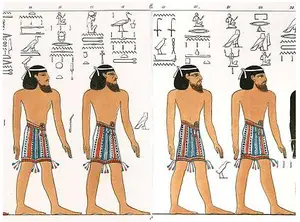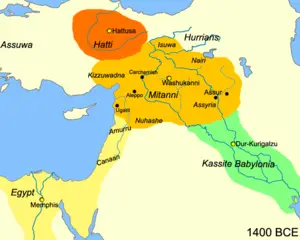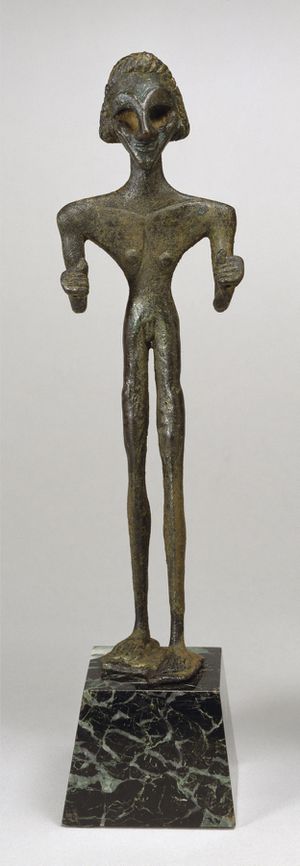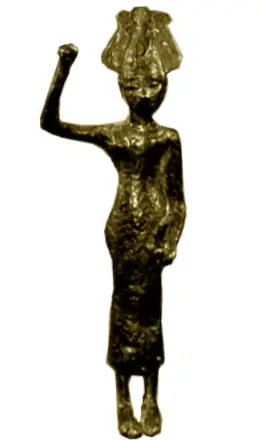What Role Did the Canaanites Play in the Bronze Age Near East
Today, the ancient Canaanites are known mainly through the lens of the Bible, but they predated the Kingdom of Israel and played a major role in the history of the ancient Near East. Although the people of the ancient Levant (roughly equivalent to the modern nation-states of Israel, Palestine, Lebanon, and southern Syria) are today collectively referred to as Canaanites and the land they inhabited Canaan, based on the biblical accounts, they were several different peoples who shared cultural and linguistic traits but never had a central government.
By the time of the Late Bronze Age (ca. 1500-1200 BC), the Canaanites began to play an increasingly important role in the Near East's political and cultural history in a variety of different ways. The Canaanite kingdoms were subordinate to the more powerful Egyptian and Hittite empires, plying them with much-needed resources and playing the role of a buffer zone and sometimes instigator when it suited their purposes. The Canaanites also influenced the region through their language and religion, spread throughout the Near East and from the Bronze Age into the Iron Age.
The Canaanite People
Much of the modern knowledge and nomenclature of the ancient Canaanites is derived from the ancient Egyptians, who were in many ways students of ethnography. Beginning in Egypt’s Middle Kingdom (ca. 2050-1710 BC), the Egyptians referred to the entire Levant, the Canaanites' homeland, as “Retenu.” [1] Later, in the New Kingdom (ca. 1550-1075 BC), in addition to the term Retenu, the Egyptians referred to parts of the Levant as “Djay” [2] and often the Canaanite people with the pejorative “vile Asiatics.” In diplomatic letters exchanged by the more powerful kingdoms of the Bronze Age Near East, the Canaanites and their land were often called “Kinahni,” [3] which may be the origin of the word Canaanite.
Concerning the ethnic and linguistic identity, they spoke a West Semitic language now termed Canaanite by scholars, which gave rise to the Hebrew and Phoenician languages in the early Iron Age. Since the Bronze Age, Canaanite culture was decentralized. Writing varied in different regions, but by 1600 BC, most of the significant Canaanite kingdoms employed an alphabetic script. [4] The creation of a written alphabet is a prerequisite to any high-functioning society as it allows people to record their religious rituals, myths, and history. Perhaps even more importantly, writing allows people to develop more sophisticated governments.
Although the Canaanites developed relatively sophisticated city-states, they never had a centralized Canaanite government, exploited by both the Hittites and Egyptians in the Late Bronze Age. Each Canaanite state was based around a fortified, sizable city controlled by a prince or king, [5] but the real powers in the region were the Hittites and Egyptians.
The Canaanites and the Great Powers of the Near East
The Canaanites became part of the power struggle between the so-called Great Powers of the Near East when the Egyptian king, Thutmose III (ruled ca. 1479-1425 BC), conquered the region.
Numerous hieroglyphic texts from Egypt document seventeen military campaigns that Thutmose III conducted into the Levant to conquer the Canaanites and later as punitive expeditions against recalcitrant city-states. [6] One text describes how the Egyptian king set the terms of Canaan’s occupation with the other great powers of Hatti, Mitanni, and Babylon (Naharin).
“Behold, these harbors were supplied with everything according to their dues, according to their contract of each year, together with the impost of Lebanon according to their contract of each year with the chiefs of Lebanon__________ 2 unknown [birds]; 4 wildfowl of this country, which [_] every day. . . The tribute of Kheta (Hatti) the Great, in this year: 8 silver rings, making 401 Deben; of white precious stone, a great block; wood _____ [returning] to Egypt, at his coming from Naharin, extending the boundaries of Egypt.” [7]
During Thutmose III’s reign, most of the city-states Canaan were reduced to Egypt’s vassals. The Egyptians quickly set about to administer the region in a way they saw fit by sending officials to rule over the major cities, such as Sumur, Gaza, and Kumidia but keeping the native Canaanite princes and kings in place to keep the peace and pay tribute. [8]
Although the Egyptians controlled the majority of the Canaanite city-states, the northern region of Canaan came to be controlled primarily by the Hittites in the Late Bronze Age. The most important Canaanite center in the northern Levant was Emar, incorporated into the Hittite Empire by the Hittite king Suppiluliuma I (reigned ca. 1370-1330 BC). Archaeological evidence shows that Emar was an important trading center where goods from Egypt, Hatti, Babylon, and later Assyria were exchanged. At its peak, Emar was just as wealthy as the more well-known coastal city of Ugarit. [9]
Amurru was another important Canaanite city in the northern Levant that became a contested state and part of the Egyptian and Hittite empires' buffer zone. The first important ruler of Amurru was King Abdi-ashirta, who pledged his fealty to the Egyptians in the fourteenth century BC. Abdi-ashirta’s son Aziru changed sides and gave his support to the Hittites, which was not uncommon in the Late Bronze Age. [10]
Although the Canaanites were never strong enough militarily to resist the greater Near Eastern powers, they often played the powers against each other to enhance their situations – for instance, if the Hittites offered Amurru less onerous tribute requirements, they could abandon the Egyptians and pledge fealty to the Hittites. [11] The Canaanites may have been militarily weak, but they were not powerless or without agency in the constant power struggles of the Bronze Age Near East.
The Canaanite Influence on Bronze Age Culture
The writing was perhaps the most important and enduring impact the Canaanites had on the Bronze Age Near East. As was mentioned earlier, the Canaanites used various written scripts, which proved to be quite adaptable. When the Great Powers of the Near East wrote their diplomatic letters to each other in the Late Bronze Age, they used the cuneiform script in a language that was a hybrid of Akkadian and Canaanite, which modern scholars know as “Canaano-Akkadian.”
The language was a blending of Canaanite and Akkadian morphology and grammar, resulting in unique texts that could usually only be read and not spoken and are the only known example of a hybrid language that was only written. [12] The Canaanites’ written and spoken languages would later influence both the Hebrew and Phoenician scripts, the latter adopted by the Greeks.
Since the Canaanites were not a unified people and lived in a region that was constantly undergoing political and cultural transition, their religion was both influenced by other peoples and later impacted different peoples. Like all of the other Bronze Age peoples, the Canaanites followed a polytheistic religion, where the gods El, Dagon, and Baal/Hadad and the goddess Anath were at the front of the pantheon. Baal, the god of rain and fertility, was the most important Canaanite god and was often syncretically combined with El and Dagon. The Canaanite goddess of war and fertility was Anath, who was the sister and consort to Baal. Anath probably originated in Mesopotamia, where she was known as Inanna to the Sumerians and Ishtar to the later Babylonians and Assyrians. [13] The importance of Baal, Anath, and Dagon to the Canaanites is reflected in an ancient Canaanite epic.
“Puissant Baal lifts his eyes, lifts his eyes, and beholds, beholds the maiden Anath, fairest among Baal’s sisters. Before her, he rises, he stands, at her feet, he kneels and falls. And he lifts his voice and cries: ‘Hail sister, and . . .! the horns of thy . . . O maiden Anath, the horns of they . . . Baal will anoint, Baal will anoint them in flight” . . . Baal goes up in the mou[ntain], Dagon’s Son in the s[ky]. Baal sits upon [his th]rone. Dagon’s son upon [his se]at.’” [14]
Just as Inanna/Ishtar spread to the Levant and was transformed into Anath by the Canaanites, the Canaanite gods and goddesses were adopted by and evolved with other peoples. In the early Iron Age, the Phoenicians accepted Baal as their primary god and later took his worship with them to Carthage. Likewise, although the Iron Age Israelites primarily worshipped Yahweh, I Kings tells of how the King of Israel, Ahab (ruled 885-850 BC), married a Phoenician woman and converted to Baal worship. Finally, the goddess Astarte, an Egyptianized version of Anath, became popular in Egypt during the Late Bronze Age.
Conclusion
The ancient Canaanites did not wield the military or diplomatic power of other peoples in the ancient Near East. However, they nonetheless still played a major role in the historical development of the region. The Canaanites’ role as vassals to the Egyptians and Hittites was important because they served as a buffer zone between the two powerful states and sometimes as an instigator of conflicts. Perhaps the Canaanites' most profound influence on the history of the ancient Near East was cultural, particularly in language and religion, because other peoples adopted their form of writing and some of their deities.
References
- ↑ Kuhrt, Amélie. The Ancient Near East: c. 3000-330 BC. (London: Routledge, 2010), p. 313
- ↑ Faulkner, Raymond O. A Concise Dictionary of Middle Egyptian. (Oxford: Griffith Institute, 1999), p. 319
- ↑ Kuhrt, p. 318
- ↑ Kuhrt, p. 303
- ↑ Kuhrt, p. 318
- ↑ Kuhrt, p. 317
- ↑ Breasted, Henry, ed. and trans. Ancient Records of Egypt. Volume 2, The Eighteenth Dynasty (Chicago: University of Illinois Press, 2001), p. 204
- ↑ Kuhrt, p. 325
- ↑ Kuhrt, p. 315
- ↑ Kitchen, Kenneth A. On the Reliability of the Old Testament. (Grand Rapids, Michigan: Williams B. Eerdmans Publishing, 2003), p. 166
- ↑ Kuhrt, p. 236
- ↑ Dassow, Eva von. “Canaanite in Cuneiform.” Journal of the American Oriental Society. 4 (2004) pgs. 642-50
- ↑ Hillers, Delbert A. “Analyzing the Abominable: Our Understanding of Canaanite Religion.” Jewish Quarterly Review. 3 (1985) p. 258
- ↑ Pritchard, James B, ed. Ancient Near Eastern Texts Relating to the Old Testament. 3rd ed. (Princeton, New Jersey: Princeton University Press, 1992), p. 119



